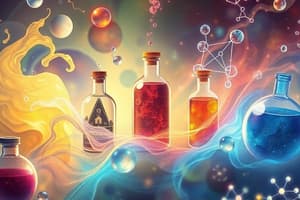Podcast
Questions and Answers
What is the primary reason that water and hydrogen peroxide have different identities?
What is the primary reason that water and hydrogen peroxide have different identities?
- They have different temperatures.
- They have different combinations of atoms. (correct)
- They are in different states of matter.
- They contain different numbers of protons.
Which of the following is true about mixtures?
Which of the following is true about mixtures?
- All mixtures are homogeneous.
- Mixtures are chemically combined.
- Components in a mixture can be physically separated. (correct)
- Mixtures cannot contain liquids.
What type of mixture is Italian Salad Dressing categorized as?
What type of mixture is Italian Salad Dressing categorized as?
- Homogeneous mixture
- Solution
- Colloid
- Heterogeneous mixture (correct)
What is a characteristic of homogeneous mixtures?
What is a characteristic of homogeneous mixtures?
Which of the following best describes a solution?
Which of the following best describes a solution?
Which of the following is NOT an example of a solution?
Which of the following is NOT an example of a solution?
What defines a heterogeneous mixture?
What defines a heterogeneous mixture?
Alloys such as brass are categorized as solutions because:
Alloys such as brass are categorized as solutions because:
What distinguishes an element from a compound?
What distinguishes an element from a compound?
Which of the following statements is true regarding compounds?
Which of the following statements is true regarding compounds?
How is the chemical formula of water represented?
How is the chemical formula of water represented?
Which statement correctly describes elements listed on the periodic table?
Which statement correctly describes elements listed on the periodic table?
What is the fundamental difference between mixtures and compounds?
What is the fundamental difference between mixtures and compounds?
Which of the following statements about distinct substances in a mixture is correct?
Which of the following statements about distinct substances in a mixture is correct?
Which of the following is an example of a compound?
Which of the following is an example of a compound?
How many known elements are listed on the periodic table?
How many known elements are listed on the periodic table?
Flashcards
Element
Element
A pure substance that cannot be broken down into simpler substances.
Compound
Compound
Two or more elements chemically combined in a fixed ratio.
Mixture
Mixture
Substances that are physically combined.
Solubility
Solubility
Signup and view all the flashcards
Solute
Solute
Signup and view all the flashcards
Solvent
Solvent
Signup and view all the flashcards
Solution
Solution
Signup and view all the flashcards
Suspension
Suspension
Signup and view all the flashcards
Homogeneous mixture
Homogeneous mixture
Signup and view all the flashcards
Alloy
Alloy
Signup and view all the flashcards
Study Notes
Categories & Composition of Matter
- Matter has mass and takes up space
- Substances have a definite composition
- Mixtures have a variable composition
- Substances are categorized as either elements or compounds
- Elements are pure substances with only one type of atom.
- Compounds are pure substances formed from two or more combined elements with fixed proportions.
- Mixtures are made up of two or more substances mixed in any proportion.
Substances
- Substances cannot be broken down into simpler components and still maintain their properties.
- Two categories of substances are elements and compounds.
Elements
- Elements are pure substances in which all atoms are identical.
- Elements cannot be separated into other substances.
- All elements are listed on the periodic table.
- There are 115 known elements.
- Ninety are naturally occurring on Earth; 28 are synthetic.
Compounds
- Compounds are substances where atoms of two or more elements are combined in fixed proportions.
- Proportions of elements in a compound are always the same
- The chemical formula shows the elements in a compound and their proportions.
- Compounds have different properties than the elements that make them up.
- Examples include water (H₂O) and table sugar (C₁₂H₂₂O₁₁).
Mixtures
- Mixtures are combinations of two or more substances in any proportions. The substances in a mixture are physically combined.
- Each substance in a mixture retains its properties.
- Mixtures can be separated into their components by physical methods.
- Example: Salt water can be separated by evaporation, and iced tea components include tea, sugar, lemon, and mint.
Types of Mixtures
- Heterogeneous Mixtures: Different materials are easily distinguishable (e.g., granite, a salad.)
- Homogeneous Mixtures (Solutions): Components are blended evenly throughout (e.g., alloys, soft drinks, air).
- Particles in solutions are too small to be seen with a microscope. These particles are atoms or molecules, and remain evenly distributed.
- Solutions can contain liquids in liquids, solids in liquids, gases in liquids, gases in gases, and solids in solids (e.g., alloys).
- Colloids: Particles don't settle but scatter light (e.g., milk, fog, paint); the particles are larger than those in a true solution but smaller than a suspension.
- Suspensions: Heterogeneous mixture where visible particles settle over time (e.g., muddy water, Italian salad dressing.)
Alloys
- Alloys are metal mixtures which are solid solutions.
- Examples of alloys include brass (copper and zinc), bronze (copper and tin), and stainless steel (iron, carbon, chromium, and other metals).
Properties of Compounds vs. Mixtures
- Compounds have completely new properties that are different from the properties of the component elements.
- Examples include table salt (sodium chloride). White salt crystals are made from yellow-green chlorine gas and highly reactive silver-colored sodium metal, which all have very different properties when alone
- In mixtures, properties of the mixture are a blend of the properties of the components.
Studying That Suits You
Use AI to generate personalized quizzes and flashcards to suit your learning preferences.



